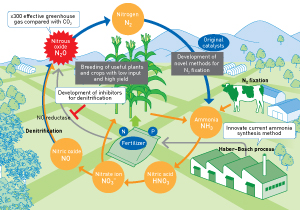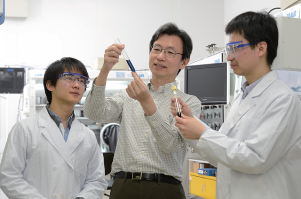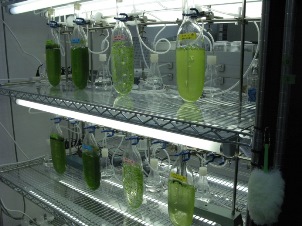Jul. 25, 2014 Perspectives Biology Chemistry Engineering
Cultivating a renewable future
Scientists at RIKEN learn from nature to maximize agricultural productivity, remove harmful pollutants from the environment and create new ‘green' materials.
Our society enjoys steadily improving technological capabilities and quality of life, but these advances could come at a severe cost unless we plan for the wellbeing and security of future generations. We now recognize the dangers associated with unfettered use of fossil fuels such as coal and oil, which have powered civilization for nearly two centuries. Scientists have gathered powerful proof that atmospheric accumulation of waste products from fossil fuel consumption—most notably carbon dioxide—is actively driving climate change. Although the full consequences of this shift remain to be seen, indicators such as abnormal weather patterns and accelerating polar ice melt demonstrate the seriousness of our situation.
In parallel with these climatic risks, the demands of a steadily growing population threaten to exceed the finite supply of raw materials. Ensuring food security must be a priority; this will require developing crops with improved productivity that are suited to a changing global environment. Food, however, is not the only limited resource. Businesses and households depend on goods manufactured from plastics and metals—often produced in ways that are inefficient, environmentally destructive or dependent on scarce materials.
Productive plants, clever chemicals
 Figure 1: Interdisciplinary research at the RIKEN Center for Sustainable Resource Science
Figure 1: Interdisciplinary research at the RIKEN Center for Sustainable Resource ScienceA broad range of research is being carried out at the center, including investigations into nitrogen management. © 2014 RIKEN
Given these many challenges, sustainable resource science must be a top research priority in the years ahead. The goal of this field is to develop technologies that will enable society to progress on a foundation of maximized efficiency and reusability, so that communities and economies continue to flourish while the environment is protected.
Scientists at RIKEN have been actively engaged in solving these problems for years. Since 2000, the RIKEN Plant Science Center (PSC) in Yokohama, which recently became integrated into the RIKEN Center for Sustainable Resource Science (CSRS), has explored the molecular foundations of plant physiology.
Every plant produces a diverse set of chemical compounds, known collectively as its ‘metabolome’, which contributes to development, disease resistance and other essential processes. The composition of the metabolome is determined both by instructions encoded within the genome and in response to shifting environmental circumstances.
Initially, the PSC focused on understanding genomic features that contribute to growth and survival in different conditions, as well as the chemical compounds that act as intermediaries. Subsequent efforts focused on identifying strategies to manipulate the genome and metabolome of key crops to maximize their durability and productivity, even in adverse conditions such as drought or extreme heat.
These discoveries demonstrated the potential for harnessing the innate adaptability of nature as a means for building more robust agricultural systems. Importantly, they also raised the intriguing possibility that insights from plant biology could address other challenges in sustainability, including environmental remediation and ecofriendly manufacturing.
Exploring these avenues of research requires a broad interdisciplinary effort. For this reason in 2013, key scientists from the RIKEN Advanced Science Institute joined researchers from the PSC to form the CSRS. Together they are pursuing a singular mission of ‘green innovation’ through the careful modification of biological systems and the construction of novel materials that could benefit agriculture, energy production and the manufacturing industry.
The valuable expertise in chemistry, chemical biology and materials science that the Advanced Science Institute brings to the collaboration promises to dramatically accelerate the molecular-scale dissection and engineering of biological processes. Over the past five years, these researchers have developed sophisticated metal catalysts that can be used to accelerate useful chemical reactions and accumulated a wealth of knowledge about the intersection between chemistry and biology. Among their many other achievements, scientists at the institute have also built a massive collection of naturally occurring, biologically active molecules known as the ‘Natural Products Depository’1.
The big picture
 Figure 2: New catalysts developed by Zhaomin Hou (center) can convert nitrogen into ammonia at room temperature. © 2014 RIKEN
Figure 2: New catalysts developed by Zhaomin Hou (center) can convert nitrogen into ammonia at room temperature. © 2014 RIKEN
Within the CSRS, every laboratory pursues a ‘core’ research program while also collaborating on three broader interdisciplinary initiatives. Each initiative revolves around a different aspect of sustainable resource production, encompassing research challenges too great for any one field to tackle alone.
The first initiative centers on carbon management. During photosynthesis, plants use biochemical reactions powered by light to incorporate water and carbon dioxide into their living structure. Given that carbon dioxide is also a primary waste product of burning fossil fuels, one could envision manipulating the photosynthetic machinery to accelerate the removal of this greenhouse gas from the atmosphere.
In parallel, chemists and materials scientists are seeking compounds that could act as synthetic catalysts to help pluck carbon dioxide out of the atmosphere. The ultimate goal would be to use the carbon recovered in either scenario as a resource to be ‘recycled’ into more useful materials.
Nitrogen management is the second initiative. Plants require nitrogen but cannot obtain it directly from the atmosphere; instead, they make use of nitrogen that has been chemically ‘fixed’ into ammonia within the soil (Fig. 1). Naturally occurring ammonia is insufficient to support large-scale agriculture so farmers rely on ammonia manufactured via the Haber–Bosch process. This technique requires high temperatures and pressures and consumes a considerable amount of fossil fuel. Potential ways to mitigate the use of this nitrogen source include engineering crop variants that require less fertilizer or novel chemical catalysts that reduce—or even eliminate—the need for fossil fuels in ammonia production.
Many of the metals most valuable to industry are also the rarest, and Japan in particular suffers from limited mineral resources. The third initiative of the CSRS is therefore to develop innovative strategies for overcoming this scarcity. One possibility is replacement; for example, hydrogen fuel cells depend on costly platinum or palladium catalysts and alternatives based on more abundant materials could help make this ‘green’ power source more widely available.
Many roads to sustainability
 Figure 3: Hitoshi Sakakibara is working with the moss Funaria hygrometrica, which absorbs gold and lead, enabling the recovery of heavy metals from the environment. © 2014 RIKEN
Figure 3: Hitoshi Sakakibara is working with the moss Funaria hygrometrica, which absorbs gold and lead, enabling the recovery of heavy metals from the environment. © 2014 RIKEN
CSRS scientists have already made important early strides in these areas. Zhaomin Hou and colleagues, for example, recently developed a titanium-based catalyst that can convert nitrogen into ammonia at room temperature2 (Fig. 2). Meanwhile, the biodiversity found in nature is providing RIKEN scientists with a valuable arsenal of tools. Researchers led by Hitoshi Sakakibara have learned a great deal about how the chemical structure of plant hormones contributes to their ability to promote shoot growth3—knowledge that could be exploited to improve crop productivity. Sakakibara and his colleagues are also working with mosses that possess an innate capacity to absorb gold and lead, a promising natural solution for recovering mineral resources or improving the health of soil and water supplies (Fig. 3).
These are only starting points, and the CSRS is actively developing technologies that can accelerate the dissection and manipulation of biological systems. A robust ‘metabolomics platform’ previously developed by scientists at the PSC can accurately measure quantities of various chemical components from a particular plant or microbe, and this has already proven invaluable as a discovery tool4. The platform can be combined with the Natural Products Depository to explore how different compounds affect the metabolic activity of organisms, a key step toward modifying existing biological processes or even engineering entirely new ones.
The discoveries made by these research programs will only have value if they can be rapidly disseminated. For this reason, the CSRS is working closely with industry partners to identify opportunities for accelerating the commercial development of sustainably derived resources. The center’s Biomass Engineering Program offers a model for such collaboration. The goal of this program is to devise bioengineered systems for producing naturally synthesized materials. Its scientists are currently working closely with the Japanese manufacturer Kaneka Corporation to develop improved biopolymers that can be assembled into plastics suitable for a wide range of applications.
This pragmatic approach, focused on existing needs and clear-cut contemporary problems, will maximize the immediate impact of the center’s sustainability research efforts. The challenges are great but so is the reward: a society whose present needs can be comfortably and affordably fulfilled, without jeopardizing the wellbeing of our descendants or our environment.
References
- 1. Osada, H. Introduction of new tools for chemical biology research on microbial metabolites. Bioscience, Biotechnology, and Biochemistry 74, 1135–1140 (2010). doi: 10.1271/bbb.100061
- 2. Shima, T., Hu, S., Luo, G., Kang, X., Luo, Y. & Hou, Z. Dinitrogen cleavage and hydrogenation by a trinuclear titanium polyhydride complex. Science 340, 1549–1552 (2013). doi: 10.1126/science.1238663
- 3. Kiba, T., Takei, K., Kojima, M. & Sakakibara, H. Side-chain modification of cytokinins controls shoot growth in Arabidopsis. Developmental Cell 27, 452–461 (2013). doi: 10.1016/j.devcel.2013.10.004
- 4. Okazaki, Y., Otsuki, H., Narisawa, T., Kobayashi, M., Sawai, S., Kamide, Y., Kusano, M., Aoki, T., Hirai, M. Y. & Saito, K. A new class of plant lipid is essential for protection against phosphorus depletion. Nature Communications 4, 1510 (2013). doi: 10.1038/ncomms2512
About the Researcher
Kazuo Shinozaki
Since joining RIKEN as a chief scientist in 1989, Kazuo Shinozaki has conducted research into molecular biology and functional genomics, with specific emphasis on plant response and tolerance to environmental stresses. More recently, his interests have also focused on the application of basic research for the sustainable production of food, biomass and energy.
